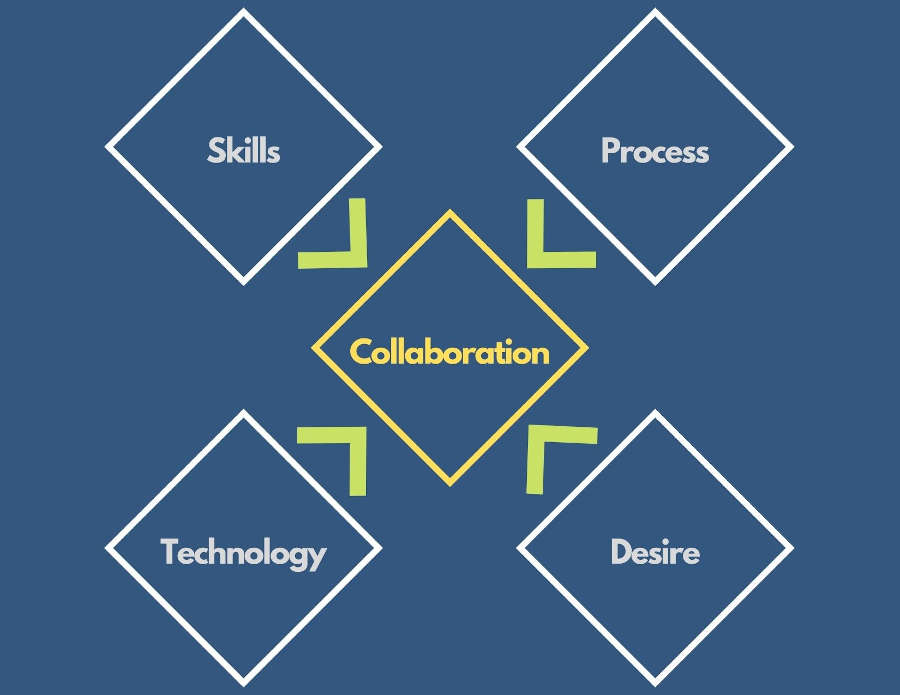A high-performance organization doesn’t develop by chance. It’s usually the manifestation of a compelling vision. This article will help you explore your collaboration vision and offer ideas for how you can bring it to life.
Have you ever sat back and asked yourself,
What would collaboration look like in my dream organization?
If you did, chances are you would next notice the differences between your collaboration vision and your current reality.
You know, you don’t have to accept the status quo. Instead you could create the vision and then get to work on bringing it to life.
Potential vision components
When considering a collaboration vision, you might first wonder what it could include. Here’s a list of common collaboration activities that may be part of your vision:
- Keeping others and yourself “in the loop”
- Sharing ideas
- Discussing ideas
- Offering and receiving feedback
- Making decisions together
- Working through differences
- Sharing and tracking work activities
- Planning
- Inspiring coworkers
- Raising issues
- Asking for help
- Influencing
- Addressing problems
- Measuring success
What would you add to the list?
Your collaboration vision
Are you ready to develop your vision? It’s time to close your eyes and dream a little. Imagine an organization in which teamwork thrives. What would be the key elements of your vision?
I recently reflected on my own business and that what I do is help others with teamwork and collaboration. My business vision could match your collaboration vision.

What this means is that collaboration should be about much more than when a group is gathered in a meeting room (or on a Zoom call).
Information should flow effortlessly regardless or where people are and the time of day. I also wanted to include the idea that status and organizational silos should not inhibit the collaboration process.
The four collaboration pillars
For you to bring collaboration to life in your organization, you could start by examining the four pillars on which successful collaboration stands.

1. Skills
It’s easy to believe everyone automatically knows how to collaborate. That’s just not true.
Communication skills are particularly important in a collaborative workplace. Examples include:
- Assertiveness
- Active listening
- Presenting information
- Writing
- Reading
Additionally there are many skills tied to emotional intelligence (E.Q.) that are necessary as well. Empathy, self-awareness, and caring are three that come to mind.
There are skills related to conflict negotiation and even technical skills required for the tools the group is using.
2. Process
I can think of dozens of process questions that need to be answered in order for a group to effectively collaborate.
They aren’t necessarily hard to answer. The problem is that most organizations don’t think to answer them.
Here are just a few examples:
- Who can initiate collaborative projects?
- How will we decide when we don’t all agree?
- How will we share files?
- Where will we store files?
- How will we maintain version control on docs?
- How will we know when to do meetings in-person vs. virtual?
- What, if any, asynchronous collaboration methods should we use?
- How will we decide when to use email vs. chat vs. phone?
- What expectations will we establish about responding to one another?
- How will we keep everyone in the loop?
- How will we track work status on projects?
Again, these aren’t hard questions. They simply need to be asked, carefully considered, answered, and then implemented.
3. Technology
In case you haven’t noticed, there is a whole lot of collaborative technology out there. Every time I stumble upon a new one, I fall in love.

There are hundreds of tools, but you can put them in a handful of categories.
- Communication
- Video conferencing
- File editing
- Cloud storage
- Project management
- Scheduling
- Creativity tools
- Meeting management
- Decision support
You already have access to some of these. Email is a collaborative technology after all. The tools getting more press these days include giants like Microsoft365, with an emphasis on Teams; Zoom for video conference, Slack for messaging, Asana for project management, and on and on.
The challenge with technology is finding something that works for you and then building adoption through a purposeful change management process.
Warning: There’s always going to be a new shiny tool. Stick with one until you have a really good reason to find something else.
4. Desire
Finally, and perhaps the most important pillar, is having people who want to work in a collaborative environment.
Teamwork isn’t for everyone. Some people are independent spirits and prefer to go their own way. They may be good at what they do, but if they aren’t willing to work as a member of a collaborative team, you’re going to have a big problem building more teamwork.
Some of this can be influenced by you. Your example, the expectations you set, and your rewards systems all contribute to how interested people are in this style of working.
What’s your vision?
It’s time. You’ve got all the background you need.
Do you want your organization to be more collaborative? Why and in what ways?
If you’re not sure how to proceed, I’d be happy to kick around some ideas with you. I’ll help you refine a vision that makes sense for your organization and then craft a plan for how to go about making it a reality.
Reach out if I can be of help.



